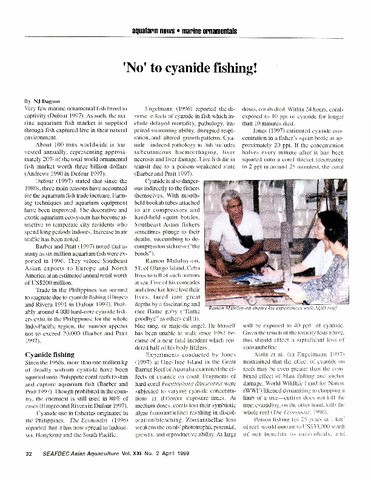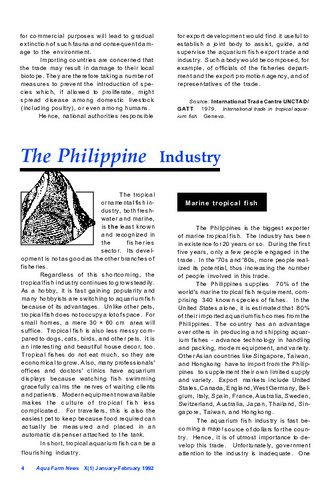Perlihatkan publikasi sederhana
The morphology and life cycle of the gill monogenean (Pseudorhabdosynochus lantauensis) on orange-spotted grouper (Epinephelus coioides) cultured in the Philippines
| dc.contributor.author | Erazo-Pagador, G. | |
| dc.contributor.author | Cruz-Lacierda, E. R. | |
| dc.date.accessioned | 2014-09-08T08:08:58Z | |
| dc.date.available | 2014-09-08T08:08:58Z | |
| dc.date.issued | 2010 | |
| dc.identifier.citation | Erazo-Pagador, G., & Cruz-Lacierda, E. R. (2010). The morphology and life cycle of the gill monogenean (Pseudorhabdosynochus lantauensis) on orange-spotted grouper (Epinephelus coioides) cultured in the Philippines. European Association of Fish Pathologists Bulletin, 30(2), 55-64. | en |
| dc.identifier.issn | 0108-0288 | |
| dc.identifier.uri | http://hdl.handle.net/10862/2132 | |
| dc.description.abstract | The morphology of Pseudorhabdosynochus lantauensis is described. It is the most numerous parasite recovered from the gills of cultured orange-spotted grouper Epinephelus coioides in the Philippines and is smaller compared with similar species reported in Hong Kong, Malaysia and Indonesia. This species is characterized by having an overlapping dorsal bar and short copulatory organ. The life cycle of the gill monogenean is also described. One mature parasite lays at least 10-22 eggs/day. Eggs are oval (0.021-0.120 mm) with a spiral filament attached to one end. Eggs hatch into free-swimming larvae (oncomiracidia) within 2-6 d at 30°C and 30 ppt. The rate of hatching of various eggs is highly variable, that is, some eggs hatch in 2 d while others take 6 d. The oncomiracidium can attach to the grouper host within 8 h. Upon attachment, the oncomiracidium metamorphoses to an adult parasite in 4-7 d. The parasite becomes fully mature and delivers eggs in 7 d. Without a host, the life span of oncomiracidium is only 4-8 h. The life cycle is complete in 13-20 days (eggs to oncomiracidium 2-6 d; oncomiracidium to adult parasite 4-7 d; adult to fully mature and egg delivery parasite 7 d). This is the first report on the morphology and life cycle of P. lantauensis from the Philippines. | en |
| dc.description.sponsorship | The authors express their gratitude to Francisco Gernade, Susan Torrento and Fely Torreta for technical assistance, Prof. Kazuya Nagasawa for technical guidance; and Dr. Elena Catap and Ms. Milagros Castaños for helpful criticism and editorial comments. This study was funded by the Government of Japan, Trust Fund under the Regional Fish Disease Project. | en |
| dc.language.iso | en | en |
| dc.publisher | European Association of Fish Pathologists | en |
| dc.rights.uri | http://creativecommons.org/licenses/by/2.5/scotland/ | |
| dc.subject | Epinephelus coioides | en |
| dc.subject | China | en |
| dc.subject | Hong Kong | en |
| dc.subject | Indonesia | en |
| dc.subject | Malaysia | en |
| dc.subject | Philippines | en |
| dc.title | The morphology and life cycle of the gill monogenean (Pseudorhabdosynochus lantauensis) on orange-spotted grouper (Epinephelus coioides) cultured in the Philippines | en |
| dc.type | Article | en |
| dc.citation.volume | 30 | |
| dc.citation.issue | 2 | |
| dc.citation.spage | 55 | |
| dc.citation.epage | 64 | |
| dc.citation.journalTitle | European Association of Fish Pathologists Bulletin | en |
| dc.subject.asfa | ectoparasites | en |
| dc.subject.asfa | fish culture | en |
| dc.subject.asfa | fish larvae | en |
| dc.subject.asfa | gill disease | en |
| dc.subject.asfa | hosts | en |
| dc.subject.asfa | life cycle | en |
| dc.subject.asfa | longevity | en |
| dc.subject.asfa | marine fish | en |
| dc.subject.asfa | parasites | en |
| dc.subject.scientificName | Pseudorhabdosynochus | en |
Files in this item
| Files | Size | Format | View |
|---|---|---|---|
|
There are no files associated with this item. |
|||
Publikasi ini ada di koleksi berikut
-
Journal Articles [1258]
These papers were contributed by Department staff to various national and international journals.





